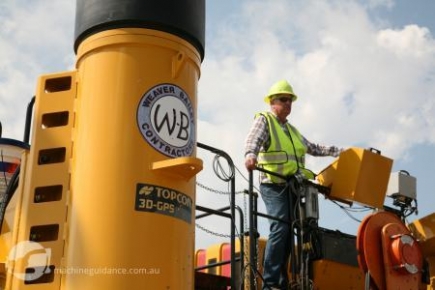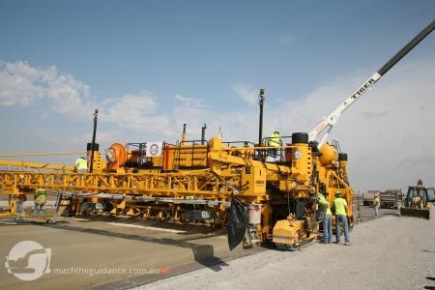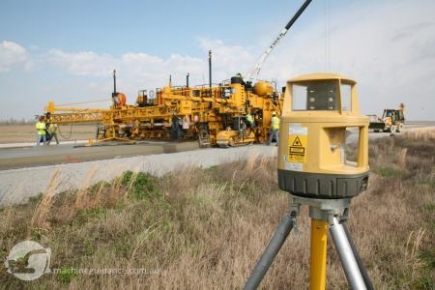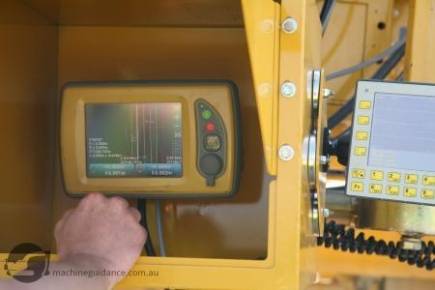Historical Road Upgrade
Contractor Weaver-Bailey is upgrading the historical U.S. Route 67 with help from cutting-edge machine guided concrete paving technology, saving "considerable time and surveyor expense."Published: May 2015
Author: Jeff Winke

text1
The southwest-northeast bisector of Arkansas, U.S. Route 67, has always been a significant motor route. In 1803, the route was known as the Southwest Trail. This old military road follows the natural break between the Ozark Mountains and the Ouachita Mountains. President Andrew Jackson appropriated money for the route in 1831, and designated it as a National Road. In the 1920s, federal money became available for road paving, and the route was officially designated U.S. Route 67. 
Over the years, U.S. Route 67 has become a relatively heavily traveled route, which has required maintenance, rehabilitation, and in some cases newly developed stretches. In 2013, the Arkansas State Highway and Transportation Department let a project for construction of a section of the new location of Route 67 which runs roughly from west of Cash north to Walnut Ridge. The project creates a two-lane divided highway in the new location, which will replace the original single-lane highway.
Weaver-Bailey Contractors Inc., based in El Paso, AR, won the project and became the general contractor on the $US20 million 9.9 mile (16 kilometer) section. Weaver-Bailey is a concrete paving specialty contractor that also performs the earthworks and grading prep work necessary for paving.  The contractor is the biggest concrete paving company in the state of Arkansas. The project commenced in January 2013 and is expected to be completed by year's end 2015.
"This is brand new roadwork being constructed on former farm land," states Roger Weaver, paving superintendent with Weaver-Bailey Contractors. "It's a challenge since the fertile soil really holds moisture. The ground is great for planting crops, but not so great for planting a concrete highway."
This past winter was mild for the area. Night-time temperatures could fall into the 20s F (-7 C), but during the day the temperatures would typically rise into the 40s F (5 C). According to Weaver, these were temperatures they could work in and pour concrete when it is high 20s F (-2 C) or warmer.

1
The new concrete highway measures 26-feet (8 metres) wide - two 12-foot (3.5 metre) wide lanes and a 2-foot (600 millimeter) shoulder on each side. Weaver-Bailey completed the highway with three layers: a cement-stabilizer base, a thin asphalt interlayer, and a surface layer, using a 14-man crew. The six inches (150 millimeters) of cement stabilizer functions as a sub-base layer reinforcing and protecting the subgrade. The 368,838 square yards (308,395 square metres) of cement stabilizer was rough graded with a dozer and finish graded with a motor grader - both equipped with machine control.
"We want to ensure accurate grade and no material waste so we use Topcon 3D-MC2", Weaver says. "We've been using GPS machine control for some time in our dirt work so we're familiar with its accuracy and production speed, which we're also seeing on the paving side as well."
Weaver-Bailey works with both TrenchSafety and Supply Inc., based in North Little Rock, AR and Topcon to match the technology to their need. "They're familiar with the benefits of machine control and have been using systems on their dirt machines for years, so it was natural for Weaver-Bailey to migrate into paving," states Steven Simon, TrenchSafety and Supply vice president / branch manager for the Memphis and Little Rock locations. "Along with Topcon and GOMACO, we performed the install and training on their GOMACO GHP-2800 slipform paver - they got up to speed quickly."
Brian Lingobardo, systems manager-3D road construction for Topcon adds: "This was a new machine and application for Weaver-Bailey so it was essential that GOMACO and Topcon were united for the start-up and training. Also, because of Weaver-Bailey's strong understanding of Millimeter GPS and the skill set of the crew, paving with 3D has been a success."
A significant benefit, according to Weaver, is that with machine control is that the project does not require stakes and the surveyors to place them. "We save considerable time and surveyor expense during all phases of the project by having the constant of the data points and design within the system," states Weaver. "It is so much easier not having to worry about running over stakes and then replacing them when it inevitably happens. A major plus is having no stringlines in the way."
The one-inch (25 millimetre) layer of asphalt interlayer was placed by a subcontractor of Weaver-Bailey. The bond breaker asphalt lift separates the finish overlay concrete from the cement-stabilizer pavement underneath. It is designed to provide support for the overlay. "We want the finished road surface to be very smooth, that's why it's critical that the cement stabilizer and asphalt interlayer surfaces are graded to tight tolerances," Weaver says. "Then, to ensure we have the smoothest concrete surface, we used Topcon Millimeter GPS technology on our GOMACO slipform paver."
The company used a four-track GOMACO GHP-2800 slipform paver equipped with a 3D paving system on the U.S. Route 67 project. The paver features IDBI in-the-pan dowel bar inserter, paving 23.8 ft. (7.25 m) wide, inserting 23 bars across the slab, 11.8 in. (300 mm) apart.

Image LHS

Image RHS
text
"The machine's operating system with stringless technology benefited us greatly in lower costs, higher production, and better results," says Weaver. "We've been using 3D paving for the past two years and like that we get real-time navigation with direct access to the design data from our CAD project model. It accommodates radii and super-elevations automatically."
Topcon's Millimeter GPS Paver System controls the lift cylinders independently. The machine operator has access to critical information. The GX-60 control box in the GOMACO paver's operator compartment features a color, graphical screen display of machine position on the job, and the sensors being used to control the left and right side of the screed, and current elevation and slope.
A 10-inch (250 millimeter) thick finish surface layer of PCCP (Portland Cement Concrete Pavement) concrete was poured using standard Class A3 concrete. The nearly 20-miles (32 kilometers) of paving will require 319,220 square yards (266,908 square metres) of PCCP concrete. Other than delays from rain, "the pour," according to Weaver, "is going smoothly, giving us the smooth road surface we are after."
For Weaver-Bailey Contractors, this Arkansas State Highway and Transportation Department project hits the sweet spot of the type of work they do. Founded in 1960 by two brothers-in-law and licensed in seven states, the family-owned company is a specialty general contractor with an emphasis on concrete paving. Today Weaver-Bailey is recognized as the largest main line concrete paver in Arkansas. The company employs approximately 100 during peak season, and a sister company, Webco Mining-an aggregate producer-employs an additional 15. 
Years from now, Weaver and his crew will be able to look at an Arkansas highway map and know that they constructed this re-routed new two-lane divided highway section of historic U.S. Route 67 from farm field to smooth concrete pavement.
Credit Source
 
Jeff Winke is a business and construction writer based in Milwaukee, Wis, USA. His portfolio can be seen at jeffwinke.contently.com.
 Return to Articles
 
 

